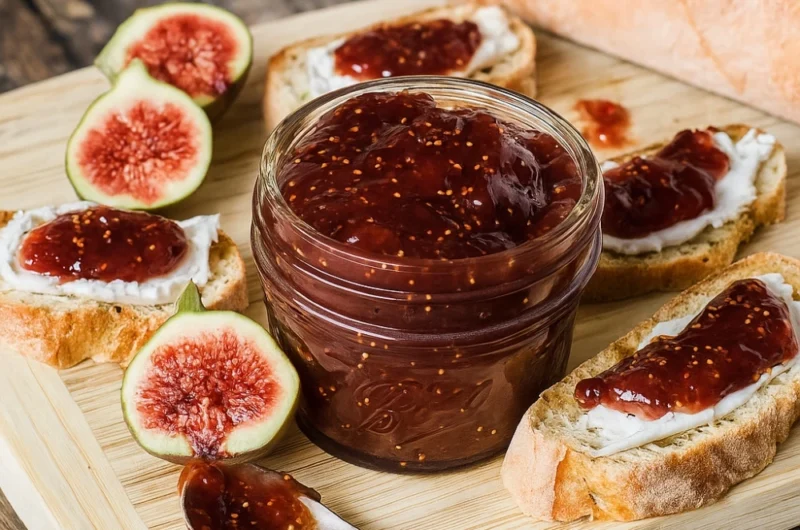The Best Fluffy Pancakes recipe you will fall in love with. Full of tips and tricks to help you make the best pancakes.
The Ultimate Foolproof Fig Jam Recipe (No Pectin Needed)

Last summer, I stood in my kitchen staring at a basket overflowing with fresh figs from my neighbor’s tree, wondering how to transform this fleeting bounty into something that would last beyond the season. That’s when I embarked on perfecting the ultimate fig jam recipe—one that would capture the essence of summer in every spoonful.
This guide goes beyond a simple ingredient list. We’ll explore the science of jam-making, offer a customizable “flavor matrix” for endless variations, and provide a visual troubleshooting guide to guarantee success every time. Whether you’re a seasoned preserving pro or a complete beginner, this foolproof fig jam recipe will become your go-to method for creating perfect homemade fig jam.
Why This Recipe is the Best
• Tested to Perfection: Developed through over 20 batches with different fig varieties and techniques to ensure consistent results • No Pectin Required: We harness the natural pectin found in figs and lemon juice, eliminating artificial additives • Fully Customizable: Our exclusive Flavor Matrix shows you how to incorporate herbs, spices, and spirits for unique variations • Troubleshooting Built-In: Visual guides help you identify and fix common issues before they ruin your batch • Science-Backed Approach: Understanding the “why” behind each step ensures consistent success • Storage Flexibility: Instructions for fresh use, refrigerator storage, freezing, and proper canning methods
Ingredient Deep Dive: Understanding Your Fig Jam Components
Fresh Figs: The Star of the Show
Not all figs are created equal when it comes to jam-making. Mission figs, with their deep purple skin and sweet, complex flavor, create a rich, dark jam perfect for pairing with aged cheeses. Brown Turkey figs offer a milder, honey-like sweetness that works beautifully in breakfast applications.
When selecting figs for your homemade fig jam, look for fruits that yield slightly to gentle pressure but aren’t mushy. The skin should be intact without cracks or soft spots. Overripe figs can make your jam overly sweet and affect the natural pectin levels, while underripe figs lack the depth of flavor that makes fig jam so special.
Sugar: More Than Just Sweetness
Sugar serves three critical functions in fig jam recipes: it acts as a preservative, helps activate natural pectin for proper setting, and balances the fruit’s acidity. Granulated white sugar provides the cleanest flavor, allowing the figs to shine.
For those seeking alternatives, honey creates a more complex flavor profile but requires reducing the liquid in the recipe by 25%. Maple syrup adds earthy notes but can overpower delicate fig varieties. Remember: sugar isn’t just about taste—it’s essential for proper jam consistency and food safety.
Lemon Juice: The Science Behind the Citrus
Fresh lemon juice is non-negotiable in easy fig jam recipes. The acid serves multiple purposes: it activates the natural pectin in figs, prevents the fruit from darkening, and provides crucial pH balance for safe preservation. The pectin molecules need an acidic environment to form the gel structure that gives jam its characteristic texture.
Always use fresh lemon juice rather than bottled—the processing reduces acidity levels and can affect your jam’s ability to set properly.
Water: The Unsung Hero
A small amount of water prevents the fruit from scorching during the initial cooking phase. As the figs release their natural juices, the added water becomes unnecessary, but it’s crucial for getting the process started safely.
The Flavor Matrix: Your Gateway to Endless Variations
| Base Recipe | Add-in Type | Amount | When to Add |
|---|---|---|---|
| 2 lbs fresh figs + 1.5 cups sugar + 3 tbsp lemon juice | Spiced | ||
| Cinnamon stick | 1 stick | Beginning of cooking | |
| Star anise | 2 pods | Beginning of cooking | |
| Cardamom pods | 4-5 pods | Beginning of cooking | |
| Herbal | |||
| Fresh rosemary | 2 sprigs | Last 10 minutes | |
| Fresh thyme | 3 sprigs | Last 10 minutes | |
| Bright | |||
| Orange zest | 2 tbsp | Last 5 minutes | |
| Balsamic vinegar | 1 tbsp | Last 5 minutes | |
| Spirited | |||
| Bourbon | 2 tbsp | After cooking, off heat | |
| Brandy | 2 tbsp | After cooking, off heat | |
| Port wine | 3 tbsp | After cooking, off heat |
Pro Tip: Start with half the suggested amount for your first batch—you can always add more to taste!
Step-by-Step Instructions: Master the Perfect Fig Jam
Preparation (10 minutes)
- Prepare your figs: Remove stems and cut larger figs into quarters, smaller ones in half. This ensures even cooking and optimal pectin release.
- Macerate the fruit: Combine cut figs with sugar in a large, heavy-bottomed pot. Let stand for 15 minutes, allowing the sugar to draw out natural juices.
Cooking Process (25-35 minutes)
- Start the cooking: Add lemon juice and water to the macerated figs. Bring to a rolling boil over medium-high heat, stirring constantly to prevent sticking.
- Reduce and simmer: Lower heat to medium-low and simmer the fig mixture for 20-30 minutes, stirring occasionally. The jam is ready when it coats the back of a spoon and passes the “plate test.”
- Perform the plate test: Drop a small amount of jam onto a chilled plate. If it wrinkles when you push it with your finger, it’s properly set.
Finishing Touches (5 minutes)
- Final adjustments: Taste and adjust sweetness or acidity as needed. Remove any whole spices used for flavoring.
- Hot pack into jars: Ladle hot jam into sterilized jars, leaving ¼-inch headspace for proper sealing.
Visual Troubleshooting Guide: Solving Common Fig Jam Problems
Problem 1: My Jam is Too Runny
Why it happens: Insufficient cooking time, not enough acid, or figs with low natural pectin content.
The Fix: Continue simmering for an additional 5-10 minutes, testing frequently with the plate method. Add an extra teaspoon of lemon juice to boost acidity and pectin activation. The jam should coat a spoon heavily and form wrinkles when tested on a cold plate.
Problem 2: My Jam is Too Thick or Candy-Like
Why it happens: Overcooking, too much sugar, or cooking at too high a temperature.
The Fix: While the jam is still hot, gradually stir in warm water, one tablespoon at a time, until you reach the desired consistency. Test again with the plate method to ensure it still sets properly.
Problem 3: Jam Won’t Set at All
Why it happens: Figs were overripe (low pectin), insufficient acid, or not cooked long enough.
The Fix: Return jam to pot, add 1-2 tablespoons fresh lemon juice, and cook for additional 5-10 minutes. For severely runny jam, add ½ packet powdered pectin mixed with 2 tablespoons sugar.
Comprehensive Canning & Storage Guide
How to Sterilize Jars
- Wash jars and lids in hot, soapy water
- Place jars in a large pot, cover with water, and boil for 10 minutes
- Keep jars hot until ready to fill
- Place lids in simmering (not boiling) water until ready to use
Water Bath Canning Method
For long-term storage, canned fig jam can last up to two years when processed properly:
- Fill hot sterilized jars with hot jam, leaving ¼-inch headspace
- Wipe jar rims clean and apply lids
- Process in boiling water bath for 10 minutes (adjust for altitude)
- Cool completely and check seals before storing
Refrigerator Storage
Fresh fig preserves will keep in the refrigerator for up to 3 weeks in clean, airtight containers. Always use clean utensils when serving to prevent contamination.
Freezing Fig Jam
Jam can be frozen for up to one year in freezer-safe containers, leaving 1-inch headspace for expansion. Thaw in refrigerator and stir well before using.
Frequently Asked Questions
Can I use dried figs for this recipe?
While fresh figs produce superior flavor and texture, you can rehydrate dried figs by soaking them in warm water for 30 minutes. Use 1 pound dried figs to replace 2 pounds fresh, and reduce added water accordingly.
Is this fig jam recipe vegan and gluten-free?
Yes! This natural fig jam contains only figs, sugar, and lemon juice—making it suitable for vegan, gluten-free, and most other dietary restrictions.
How do I make a smaller batch?
Simply halve all ingredients: 1 pound figs, ¾ cup sugar, and 1½ tablespoons lemon juice. Cooking time will be slightly reduced—start checking for doneness after 15 minutes.
What’s the difference between jam and preserves?
Fig preserves typically contain larger fruit pieces and slightly less sugar than jam. This recipe can be adapted for preserves by cutting figs into larger pieces and reducing sugar by ¼ cup.
Can I reduce the sugar in this recipe?
Sugar is crucial for proper setting and preservation. You can reduce it by up to 25%, but the jam may not set as firmly and will have a shorter shelf life. Consider using natural sweeteners like honey, adjusting liquid content accordingly.
Creative Serving Suggestions: Beyond the Toast
Fig jam uses extend far beyond breakfast applications:
Savory Pairings: Create an elegant appetizer by spreading goat cheese on crostini and topping with a dollop of fig jam and fresh thyme. The sweet-savory combination is perfect for entertaining.
Cheese Board Star: Fig jam pairs beautifully with aged cheddar, creamy brie, and sharp blue cheeses. The natural sweetness complements salty, aged flavors.
Glaze and Marinade: Thin with balsamic vinegar to create a glaze for pork tenderloin or lamb. The caramelized fruit flavors enhance roasted meats beautifully.
Dessert Applications: Swirl into vanilla ice cream, layer between cake rounds, or use as a filling for thumbprint cookies.
Breakfast Elevation: Beyond toast, try fig jam stirred into oatmeal, dolloped on Greek yogurt, or spread on warm scones.
This foolproof fig jam recipe transforms seasonal abundance into year-round enjoyment. Master these techniques, experiment with the flavor matrix, and you’ll never need another fig jam recipe. The combination of science-based methods and creative flexibility ensures success whether you’re making your first batch or your fiftieth.
Ready to start preserving? Gather your ingredients and let’s turn those beautiful figs into liquid gold that will brighten your pantry all year long.
The Ultimate Foolproof Fig Jam Recipe (No Pectin Needed)
Course: Breakfast, AppetizersCuisine: Mediterranean3
cups19
minutes45
minutes50
kcalIngredients
2 lbs fresh figs, stemmed and chopped
1 ½ cups granulated sugar
¼ cup lemon juice (fresh)
1 tbsp lemon zest
½ cup water
Directions
- Combine chopped figs, sugar, lemon juice, lemon zest, and water in a large saucepan.
- Bring to a gentle boil over medium heat, stirring often.
- Reduce heat and simmer for about 40–45 minutes, stirring frequently until the mixture thickens.
- Mash the figs lightly with a spoon or potato masher for desired texture.
- Test consistency by placing a spoonful on a cold plate; if it holds shape, the jam is ready.
- Remove from heat, let cool slightly, then pour into sterilized jars.
- Seal and refrigerate (for short-term use) or process in a water bath (for longer storage).

